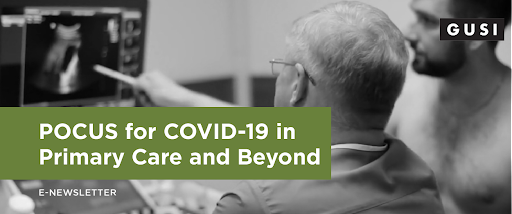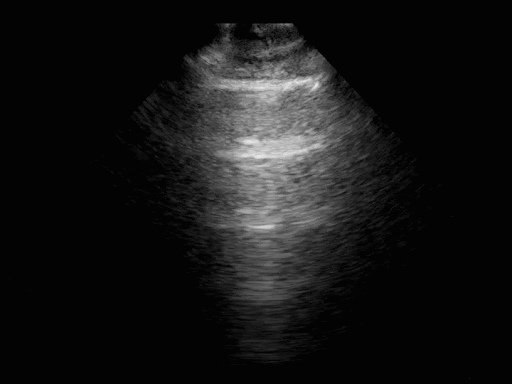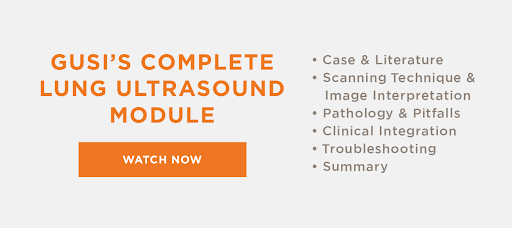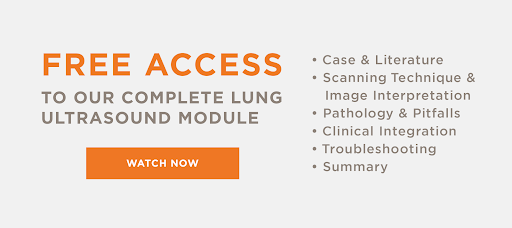E-newsletters
January 2021: POCUS for COVID-19 in Primary Care and Beyond

You’re probably aware of the critical role that POCUS is playing on the frontlines of the global COVID-19 crisis. While COVID numbers have improved, the disease is still very much with us: there were still over 66,000 new cases in the U.S. alone yesterday.
Unlike a chest x-ray, lung ultrasound can detect the virus in its early pulmonary stages, has a lower rate of false negatives, and has better negative predictive value. Unlike a CT scan, lung ultrasound has no radiation and does not require moving a patient and risking spreading the virus throughout the facility. Unlike a PCR swab, lung ultrasound offers immediate bedside results if the patient has evidence of COVID pneumonia.
But what you may not know is that POCUS also has great utility in primary care and other outpatient settings, especially during the pandemic.
Here are two clinical cases that demonstrate just how transformative POCUS can be to your outpatient practice:
Case #1: Diagnosing—or Ruling Out—COVID-19 Pneumonia
A 55-year-old woman with a history of CHF, COPD, and obesity visits her primary care doctor complaining of shortness of breath and a slight cough. She had a possible COVID exposure 10 days prior. Oxygen saturation is 94%. Differential diagnoses: worsening CHF, COPD exacerbation, bacterial pneumonia, or COVID pneumonia. Which is it?
|
Without POCUS… |
With POCUS… |
|
Physical examination. BNP test, chest x-ray, and COVID test ordered. Patient has blood drawn for a BNP test, is swabbed for COVID test, and has to follow up with imaging to receive a chest x-ray. It takes at least 1 day to receive the blood test and imaging result. >1 day to confidently diagnose COPD exacerbation. Call the patient with results. Prescribe steroids + inhaler. It takes the patient 2+ days after presenting to primary care to feel better. |
Physical examination and lung ultrasound. Ultrasound (below) shows total A-line pattern; essentially ruling out worsening CHF and pneumonia. <5 minutes to confidently diagnose COPD exacerbation. Prescribe steroids + inhaler. Patient feels better within 6 hours of presenting to primary care. |

For more info, see Sorlino, et al. (2020) here.
Case #2: Diagnosing & Predicting the Prognosis of COVID-19
A 48-year-old uninsured construction worker with a history of DM2 and HTN visits an urgent care after one week of fever, chills, and cough. He has had shortness of breath for the past two days. Oxygen saturation at 92%. Is this COVID-19, and if so, how serious is his illness?
|
Without POCUS… |
With POCUS… |
|
Physical examination. Order COVID test; patient is swabbed and returns home. Confirmation of COVID-19 received 1 day later. The patient continues self-treatment at home over the next few days as symptoms worsen. Eventually, the patient presents to the ER. Patient admitted for treatment of severe COVID-19 pneumonia 3+ days after presenting to urgent care. |
Physical examination with lung ultrasound. Ultrasound (below) shows white lung (large swaths of confluent B lines) and bilateral large lung consolidations. <5 minutes to diagnose COVID pneumonia and confirm the patient’s high risk of developing severe illness. Patient transferred to ER. Patient admitted for monitoring of worsening COVID pneumonia within 8 hours of presenting to urgent care. |

For more info, see Casella, et al. (2021) here.
Explore Our Free Lung Ultrasound Module
As you can see, POCUS is a highly effective tool for rapidly narrowing differential diagnoses–which, during the age of COVID-19, is more critical than ever before. Want to learn more and start incorporating POCUS into your primary care practice? To help, we’ve provided free access to our complete Lung Ultrasound Module! Learn the key evidence behind lung ultrasound, the basics of how to scan for a pneumothorax, pleural effusion, pulmonary edema, and pneumonia, and the most useful troubleshooting techniques to optimize your lung ultrasound scans. Plus so much more!
|

|
|

|
|
|
Sign up for GUSI’s e-newsletter and updates here.


